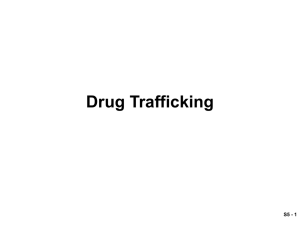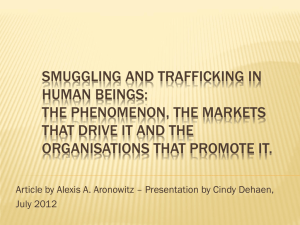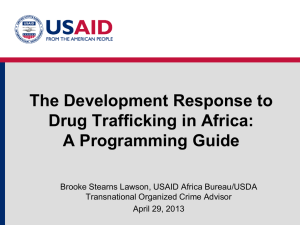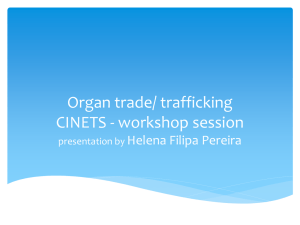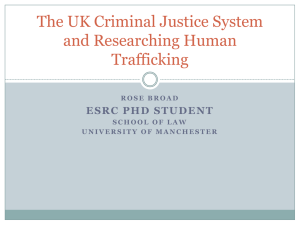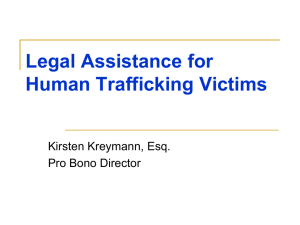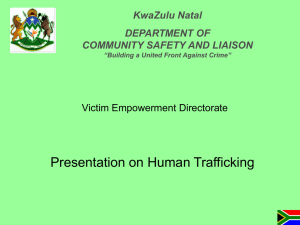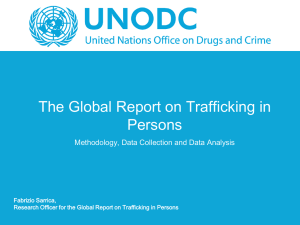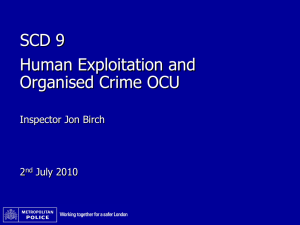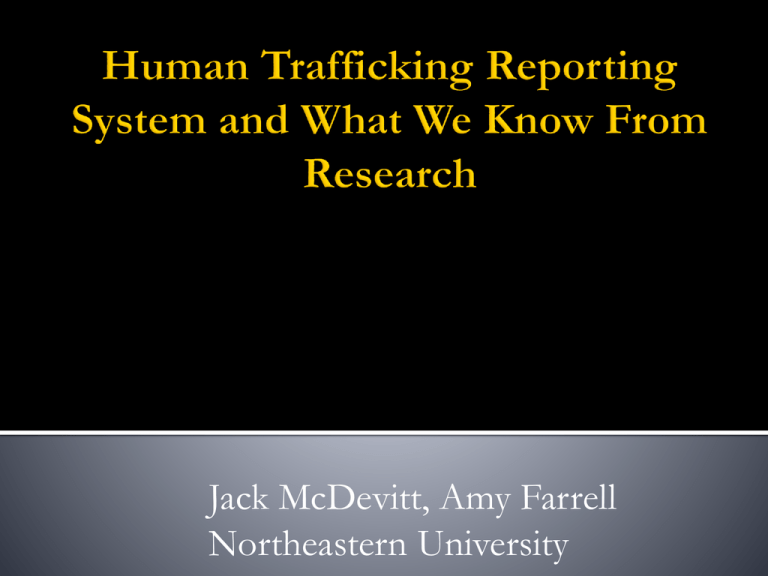
Jack McDevitt, Amy Farrell
Northeastern University
Background on Human Trafficking Legislation
Overview of current national data collection
system
Review of prior research on law enforcement
Federal definition
The recruitment, harboring, transportation, provision, or obtaining of a person
for the purpose of a commercial sex act or labor in which the act is induced by
force, fraud or coercion or, in the case of commercial sex acts which the person
forced to perform such an act is under the age of 18.
Note: U.S. definition does not require movement.
Federal legislation passed 2000, 2005, 2008
43 states have state legislation
Challenges inherent to collecting data on human trafficking
Newly recognized crime
Hidden population
Lack law enforcement training and awareness
Lack of information sharing (victim services, law enforcement and prosecutors)
Lack of familiarity by prosecutors
New laws
Challenges of state and local nexus
Lack of familiarity by courts
Bureau of Justice Statistics partnered with Northeastern University and Urban Institute
to design and implement a system to systematically collect information from law
enforcement agencies across the U.S. about human trafficking investigations
Main goal:
To collect detailed information on human trafficking investigations
investigated by law enforcement agencies across the U.S.
Began with collection of data on investigations of human trafficking from
federally funded human trafficking task forces.
42 federally funded task forces across the U.S.; represent agencies that are
trained to identify and investigate cases of human trafficking.
Led by local law enforcement agencies who partners with federal, state and
local law enforcement, victim service providers and other non-governmental
agencies.
Source: Robert Moosey, (2009). Sex Trafficking Identifying Cases and Victims, NIJ Journal, 262
Utilized HTRS data from 2007-2008
1,229 incidents identified
785 Under investigation
83% Sex Trafficking
Approximately 2 offenders and 2 victims per incident
CJ System Response
▪ 40 of cases with know suspects resulted in arrest
▪ 2/3 of cases prosecuted were prosecuted locally
▪ Of those sentenced 1/3 received a sentence of 1 year or
less
Offenders
78% male
70% 25 or older
66% U.S. Citizen
Victims
92% Female
27% Under 17 and 65% are under 26 years old
55% U.S. Citizens
National Law Enforcement Human Trafficking Survey of 3,300 local,
county and state law enforcement agencies funded by NIJ
National random sample (response rate 60%)
Supplemental sample of all agencies serving populations over 75,000 (response rate
75%)
Two questionnaires design
▪ short questionnaire on perception, preparation and identification of human trafficking
cases between 2000 and 2006
▪ detailed questionnaire for those agencies who investigated a case of human trafficking
about nature of cases and their experiences
Case studies of Multi-Agency Law Enforcement Task Force Responses
Survey of primary local law enforcement partners for each of the 42 federally funded
human trafficking task forces (response rate 86 percent)
Case studies of each of the 42 task forces
Intensive case studies in Boston, MA; Phoenix, AZ; and Houston, TX
50%
40%
Random Sample
30%
18%
20%
14%
15%
10%
10%
7%
8%
6%
6%
0%
Labor Trafficking- Labor Traffickingforeign
domestic
Sex Trafficking-
Sex Trafficking-
foreign
domestic
Medium to Large
Agencies
75% of local law enforcement leaders think human trafficking is
non-existent in their community
Local law enforcement minimally prepared to identify and
respond:
18% of municipal and county agencies have had some type of human trafficking
training
9% have a protocol or policy on human trafficking
4% have designated specialized units or personnel to investigate human trafficking
Only 7 percent of municipal and county agencies investigated
human trafficking cases
Larger agencies more likely to perceive trafficking to be a problem, take steps to
prepare their officers to identify cases, investigate human trafficking cases and
- Farrell et al., 2008 , National Law Enforcement Human Trafficking Survey
50%
39%
40%
Random Sample
30%
Medium to Large
Agencies
16%
20%
18%
9%
10%
13%
4%
0%
Specialized Unit
or Personnel
Training
Policy/Protocol
800
750
700
600
454
500
400
272
200
263
271
300
212
175
100
0
2000
2001
2002
2003
2004
2005
2006
Locations with Task Forces were more likely to
find cases and to make arrests
Coordination across law enforcement agencies
is difficult
Coordination between NGO’s and law
enforcement is also difficult
Relationships are key to improving coordination
Law enforcement overwhelmingly
reports sex trafficking investigations
Sex Trafficking
Labor Trafficking
Unknown
Kyckelhahn et al., Bureau of Justice Statistics, 2009
Victim services
disproportionately serving
labor trafficking victims
Sex trafficking
Labor trafficking
Sex and labor
Office of Victim Services, 2009
Unknown
Data from Federally funded human trafficking task forces:
25% of sex trafficking cases involve multiple victims compared to over 50% of
labor trafficking cases
Sex trafficking victims younger than labor trafficking victims (one third less than
18 years old)
Local law enforcement more likely to be lead investigating agency in sex trafficking
cases (85% local le lead in sex trafficking compared to 60% labor trafficking)
Majority of sex trafficking investigations involve U.S. citizen victims and
perpetrators
-
Kyckelhahn et al., Bureau of Justice Statistics, 2009
Many victims of human trafficking are
unidentified and consequently not helped
With proper preparation and training law
enforcement agencies can identify victims and
arrest offenders
Work still needs to be done helping law
enforcement coordinate across Federal State
and Local and to work with NGOs
Thank You

